Our Breeds
Our farm is home to a wide variety of chickens — from rare and colorful layers to reliable homestead classics. Each breed has been carefully chosen not just for its looks and temperament, but also for the genetics behind it. We love experimenting with color genes and keeping unique, high-quality lines. This page makes it easy to explore them all, learn about their genetics, and find the ones that might be the perfect fit for your flock.

Silkies
Silkies are a unique and popular breed of chicken known for their soft, fluffy feathers that feel more like fur or silk, giving them a distinctive, almost plush toy-like appearance. Their feathers lack barbicels, which is why they appear more like down. Silkies come in a variety of colors, including white, black, buff, and blue. They have black skin, blue earlobes, and five toes on each foot, which is unusual since most chickens have four.
Silkies are small, with a calm and friendly temperament, making them great pets and excellent for children. They are also known to be very broody, often used to hatch eggs of other birds. Although they are not prolific egg layers, they produce small cream-colored eggs. Their gentle nature makes them a favorite for backyard flocks and ornamental use.
We currently have 4 coops of silkies: all white, black/paint, silver pencil laced satin and a gold project coop.
Purchase Hatching eggs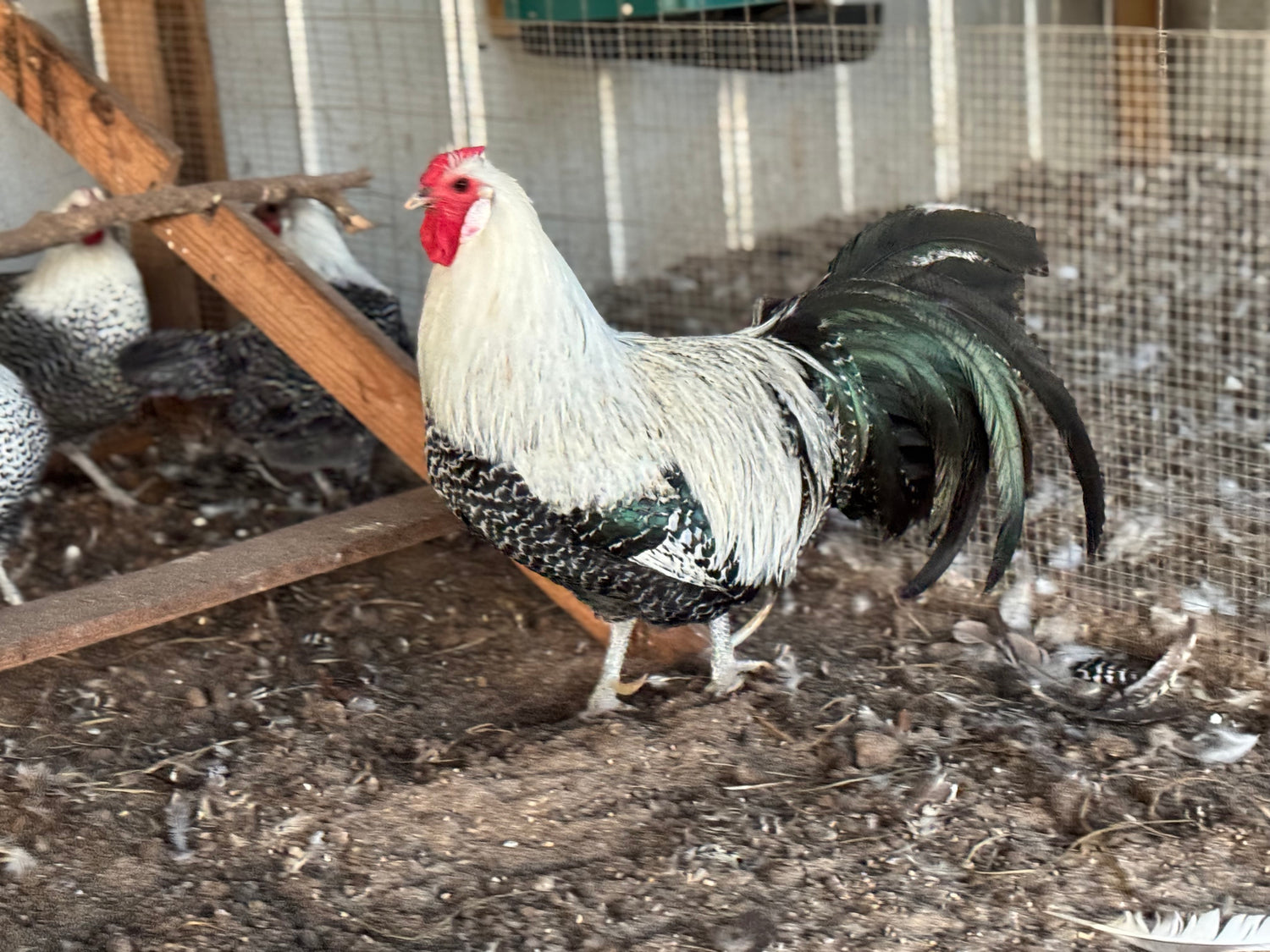
Silver Deathlayers
We are constantly amazed by our Silver Deathlayers, a breed of chicken that's as captivating as its name suggests! Originating in Germany, these birds carry a name that might raise a few eyebrows. "Deathlayer," a translation of the German "Totleger," paints a vivid picture. But it’s not as grim as it sounds. The name is a tribute to these chickens' phenomenal egg-laying prowess. Unbelievably, they continue laying eggs throughout their whole lives, defying the usual poultry norms. That's right, these feathery wonders don't let age slow them down!
But their egg-laying capabilities aren't the only thing that sets them apart. The Silver Deathlayers are a sight to behold! They sport a mesmerizing silver-white plumage that glistens in the sunlight, often appearing like tiny little white hearts all over their chests. The roosters strut around flaunting a more vibrant color palette, with black, white, and even green adorning their spectacular iridescent tail feathers. With their dark red-orange eyes standing out against their white earlobes, they're a living, breathing work of art!
Deathlayers are not large birds, with hens measuring up to around 4.5 pounds and roosters going up to about 6 pounds. But don't let their size fool you! These are hardy little warriors that can forage like no other, making the most out of their surroundings.
Known for their friendly and calm temperament, they're neither flighty nor aggressive, making them perfect companions for those backyard poultry enthusiasts. And the hens? They're not just great layers but also excellent mothers, often going broody.
So, there you have it! The Silver Deathlayers, with their intriguing name, dazzling looks, unrivaled egg-laying abilities, and pleasant demeanor, are truly a treasure in the world of poultry. A breed that's not just a pretty face but a life-long egg provider, a hardy survivor, and a friendly pet. A breed that's nothing short of extraordinary!
-

Heritage Breed
Silver Deathlayers were originally imported to the United States from Germany in 2016, by Greenfire Farms. Some of our flock originates from this original line. Greenfire farms (and others) have imported deathlayers several additional times in the last decade, which has created the genetic diversity of the Silver deathlayers we have today.
-
Silver VS Gold
Silver deathlayers hatch with a set of distinctive white stripes along their back. The silver gene in chickens is one of the key genes that affect feather color in these birds. This gene acts on the base color of the chicken, altering the expression of pigments in the feathers.
In chickens, the color of feathers is primarily determined by two pigments: eumelanin, which produces black or dark brown coloration, and pheomelanin, which gives a red or yellow color. These pigments can be modified by various genes, including the silver gene, to produce a wide variety of feather colors and patterns.
The silver gene, scientifically known as the S-locus, is primarily responsible for restricting the expression of pheomelanin (the red/yellow pigment). When a chicken has the silver gene, any areas of the feather that would normally be red or gold due to the expression of pheomelanin are instead silver or white. -
Learn more about the Silver gene here
The silver gene is dominant, which means that only one copy of the gene is needed for the effect to show up in the chicken's feathers. This means if a chicken inherits the silver gene from either parent, it will express the silver feather color.
The Silver Deathlayer, to bring this back to the topic, gets its name from the expression of the silver gene which gives these chickens their distinctive silver-white coloration. The silver gene is also responsible for the coloration of other chicken breeds like the Silver Laced Wyandotte and the Silver Spangled Hamburg.
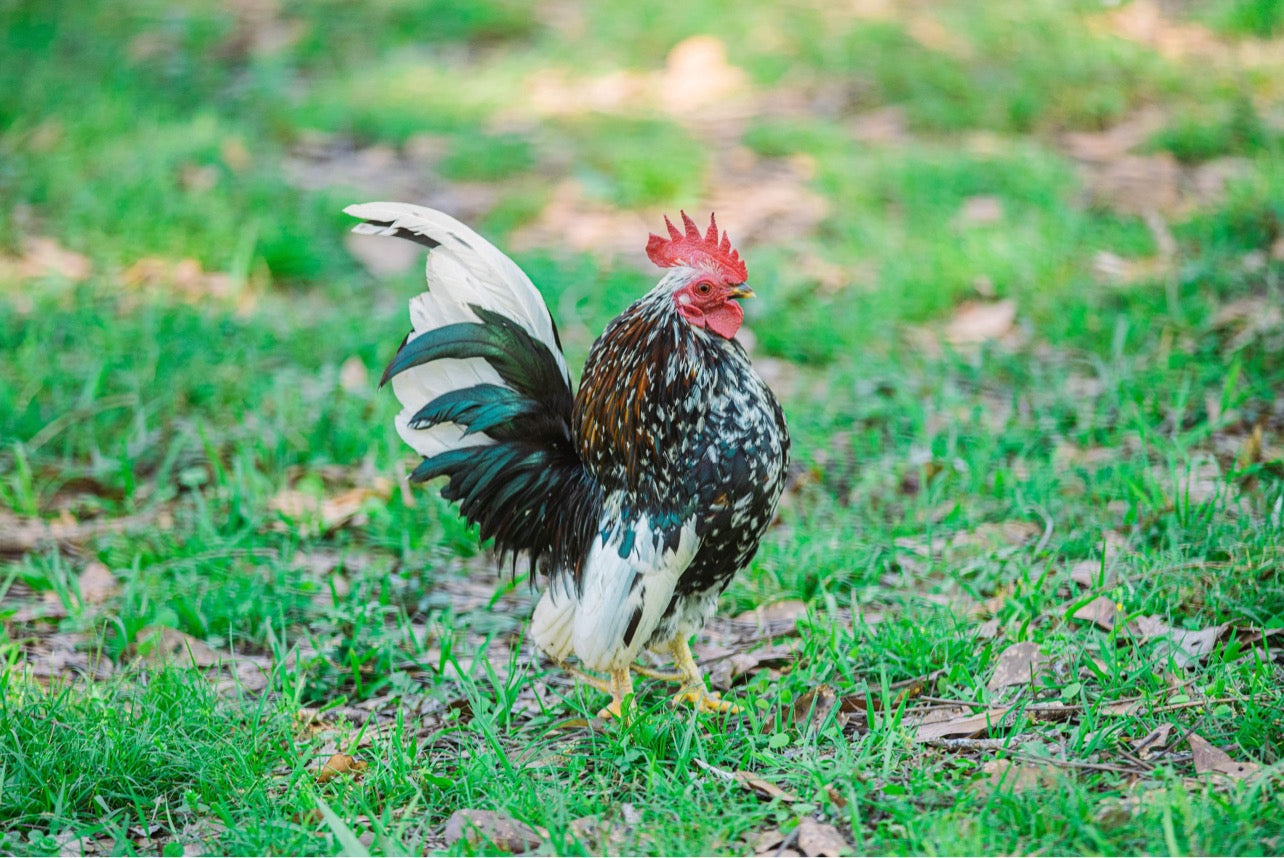
Malaysian Micro Seramas
Have you ever laid eyes on a chicken so tiny that it could fit in the palm of your hand? Enter the world of Malaysian micro Seramas, where these miniature chickens reign supreme with cuteness and grace.
Originating from Malaysia, the Serama breed has captivated poultry enthusiasts around the globe with its unique characteristics. Known as the smallest breed of chicken in the world, these little darlings have stolen hearts with their petite size, upright posture, and captivating personalities.
One of the defining features of Malaysian Seramas is their exceptional carriage. With their heads held high, chests puffed out, and wings neatly tucked, these birds exude an air of confidence and regality. Their upright stance and wings pointed straight down they are an amazing sight to see!
But don't let their small stature fool you - Seramas are big on personality! They are the ideal “picket chicken”, they possess an abundance of energy and spunk but are also cuddle-bugs. These feathered bundles of joy are known for their sweet and inquisitive nature, making them delightful pets and perfect additions to any backyard flock.
Our Seramas showcase a variety of colors and feather patterns. From solid black to striking gold, wheaten, mottled, laced, and even frizzled feathers, you never know what color will hatch. Their plumage is often intricate and beautifully detailed, with each bird possessing its own unique combination of colors and markings.
Apart from their aesthetic appeal, Malaysian Seramas are also popular for their ability to lay an abundance of tiny eggs, adding a touch of practicality to their charm. They are perfect for one-bite hard boiled eggs!
Whether you're a seasoned poultry enthusiast or just beginning your chicken-keeping journey, Malaysian Seramas are a breed worth considering. Their compact size makes them suitable for urban environments, and their friendly nature makes them great companions for both adults and children alike.
🐔❤️👑
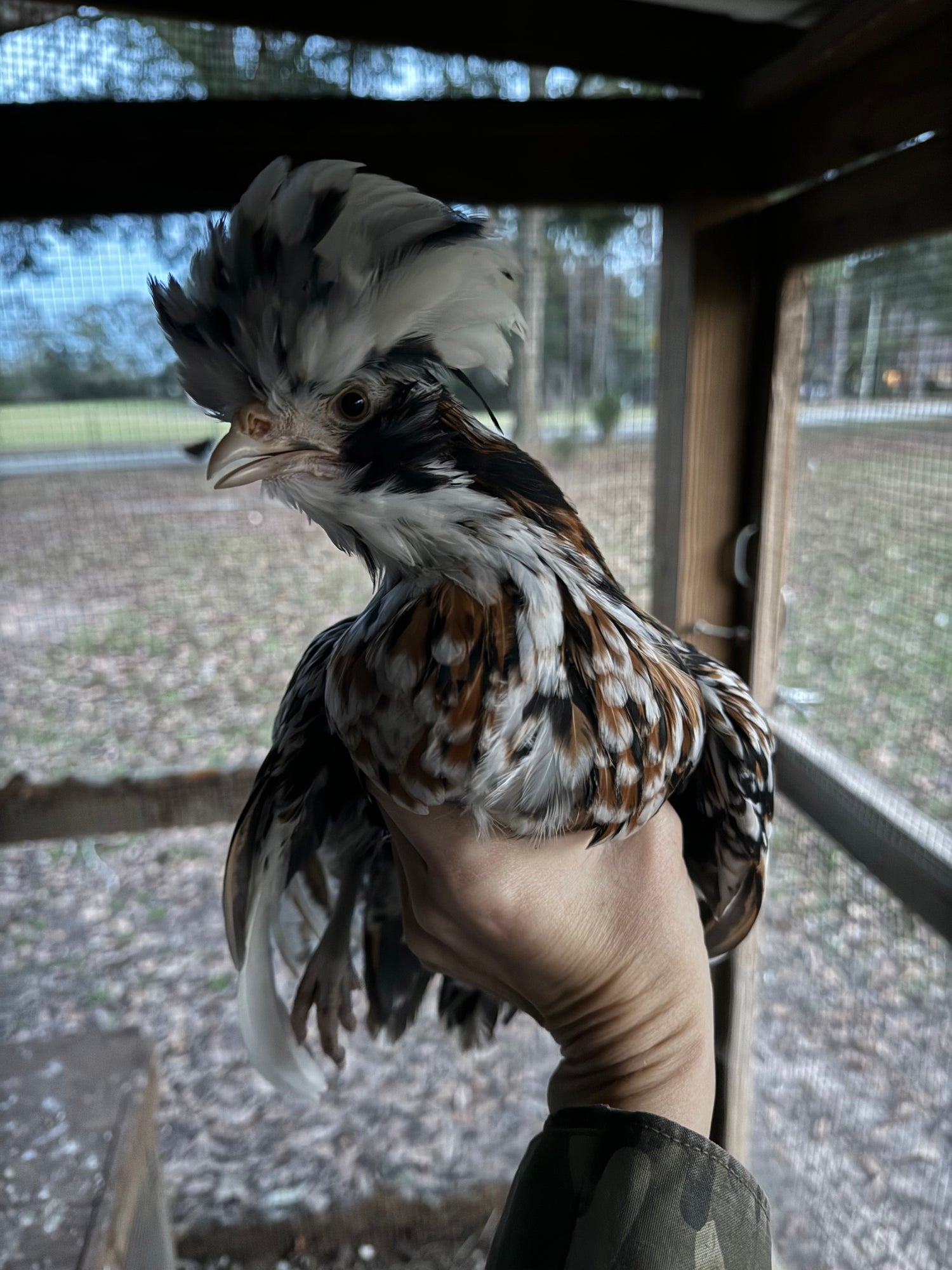
Tolbunt Polish
Meet the Tolbunt Polish Chicken, a breed that is sure to captivate anyone with its unique and enchanting appearance. With its striking plumage and distinctive crested head, this breed is a true beauty to behold.
The first thing that catches your eye is the stunning array of colors on the Tolbunt Polish. Its feathers are a mesmerizing blend of black, gold, and white, creating a mosaic-like pattern. The contrast between the dark and light colors gives these chickens an elegant and regal look that is sure to turn heads. Younger birds should be born with more black plumage which will whiten with age through molts. But what truly sets the Tolbunt Polish Chicken apart is its majestic crest and beard.
Beyond their captivating appearance, Tolbunt Polish Chickens are known for their friendly and docile nature. They have a gentle temperament, making them a pleasure to interact with and handle. Whether you're a seasoned poultry keeper or a beginner venturing into the world of chicken-keeping, the Tolbunt Polish Chicken's easy-going personality makes them a joy to care for.
Despite their ornate appearance, Tolbunt Polish Chickens are surprisingly adaptable to various environments. They can thrive in both urban and rural settings, making them suitable for backyard coops or larger poultry operations. Their adaptability, combined with their low maintenance requirements, makes them an excellent choice for chicken enthusiasts of all levels of experience.
If you're looking to add a touch of elegance and charm to your flock, the Tolbunt Polish Chicken is the perfect choice. Not only will they enhance the visual appeal of your poultry yard, but they will also bring joy and fascination with their unique personality. So why wait? Embrace the enchantment of the Tolbunt Polish Chicken and watch your flock come to life with beauty and grace.
Tolbunt Polish Genetics
-
Mottled plus Gold-Laced
Tolbunt Polish should be approximately 50% black (or reddish black due to the Gold gene), 25% reddish-brown and 25% white.
-
Breed back to Gold-Laced
Breeding your Tolbunt back to Gold-laced produces splits which keeps the lacing crisp in the resulting offspring.
-
Frizzled/Smooth
Our Tolbunt polish rooster is a frizzle and all of our hens are smooth. This results in approximately 25% frizzled offspring.
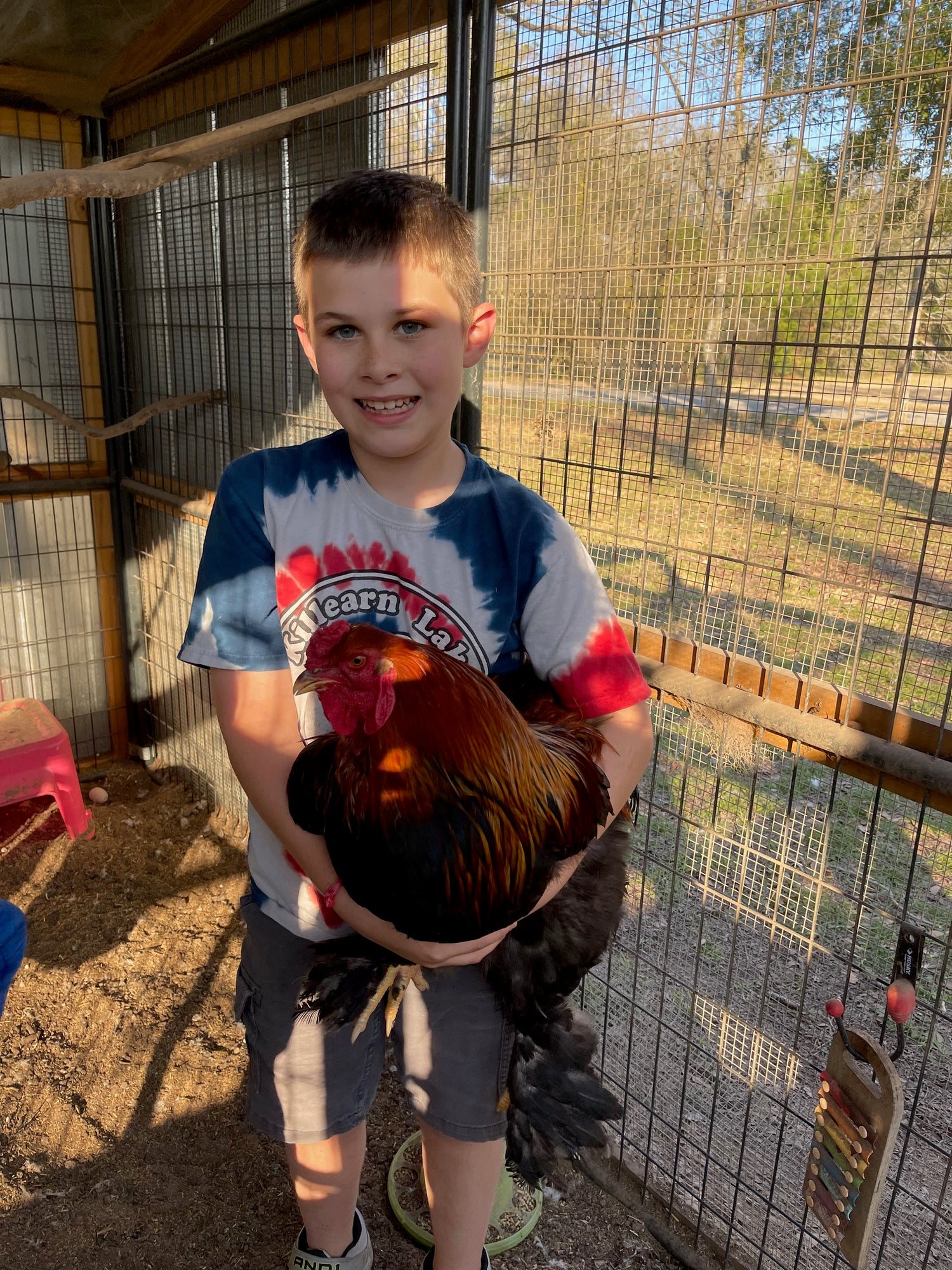
Blue/Black/Splash Partridge Brahma
Brahma chickens, originating in the United States during the mid-1800s, are a distinctive and substantial breed of domestic poultry.
Renowned for their impressive size, Brahma roosters can weigh between 12 to 18 pounds, while hens typically range from 9 to 12 pounds, making them one of the heaviest chicken breeds, recognized by the APA.
Their unique personalities set them apart from other domestic breeds, with inquisitive nature and sweet demeanor. Known for their gentle and friendly temperament, Brahmas are often recommended as pets for families.
Their feathered shanks and toes contributing to their distinctive appearance, creating a "pantaloon" look, which is quite amusing to observe in your chicken yard.
Brahma chickens come in various color varieties, including Light, Dark and Buff, each with specific color patterns. Our Brahmas are a PROJECT color and are a work in progress. We offer our project breeds to further their projects, hoping that you will love BBS Brahmas just as much as we do!
While they may not be the most prolific egg layers, they do produce a respectable number of large brown eggs. Their hardiness and ability to withstand cold temperatures, coupled with their suitability for colder climates, make them popular choices for poultry enthusiasts.
PLEASE NOTE: We currently have two Brahma pens, one is Silver and the other is all Gold birds While technically the word “partridge” indicates that the bird is GOLD… and a silver bird is called “silver orange”. We LOVE the look of the silver orange roosters and the hens are BEAUTIFUL!
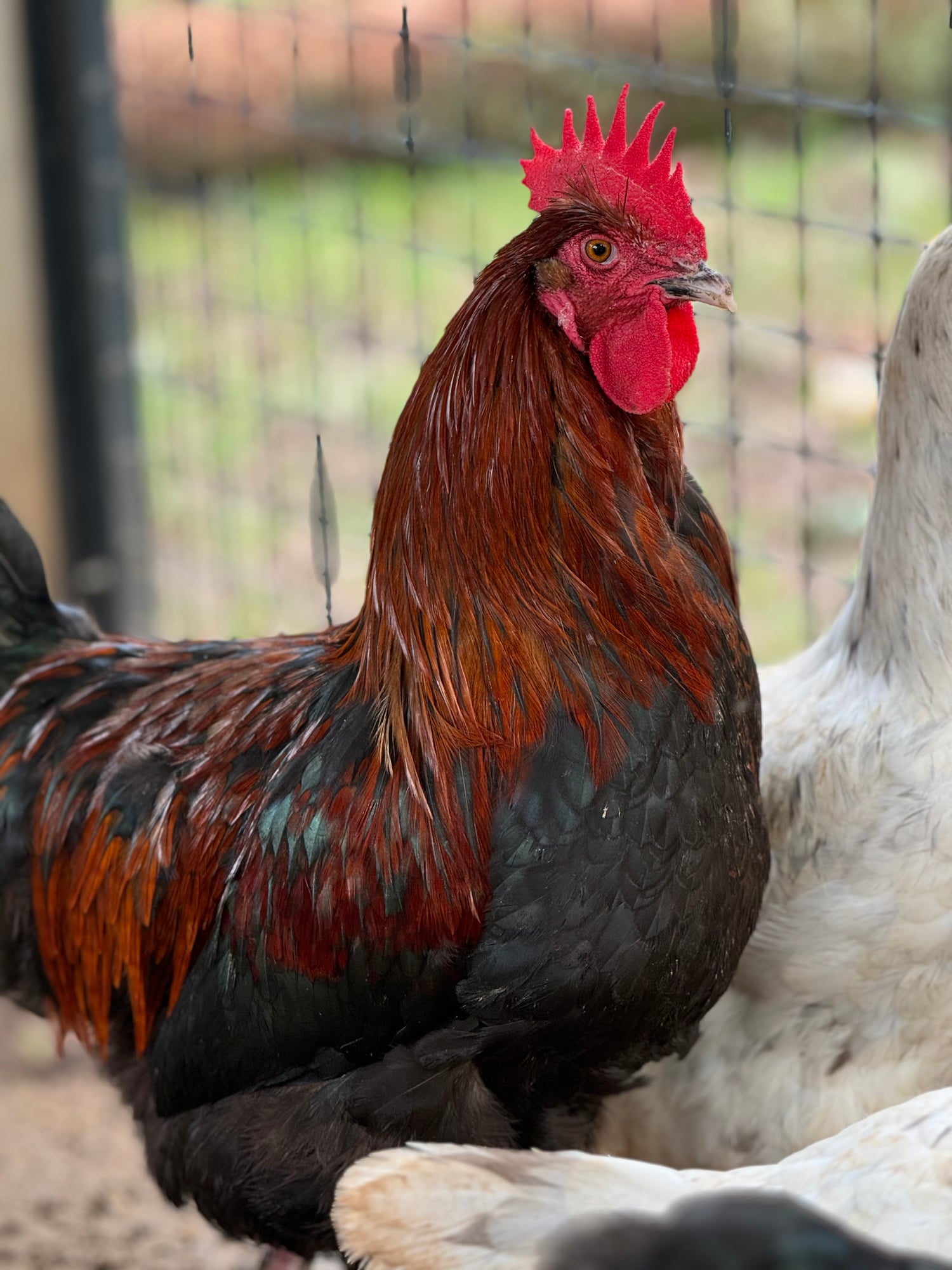
Blue/Black/Spash Copper Maran
Our BBS copper Maran coop currently consists of two black copper Maran roosters, four splash copper Maran hens and 3 black copper Maran hens.
Black Copper Marans are a breed of chicken known for their dark chocolate-colored eggs, which are among the darkest of any breed. They have a striking appearance, with black feathers that have an iridescent green sheen, and copper-colored feathers around the neck and shoulders in roosters. Hens have a subtler copper coloration. These birds are medium to large in size, with a sturdy, robust build. Black Copper Marans are known for their calm and friendly temperament, making them suitable for both backyard flocks and farms. They are decent egg layers, producing about 150-200 eggs per year.

Blue/Black/Splash Bantam Polish
Our BBS bantam polish pen currently has frizzle and smooth hens with smooth roosters.
Bantam Polish chickens are small, ornamental birds known for their unique appearance, especially their large, fluffy crests of feathers on their heads. These crests can sometimes obstruct their vision, giving them a comical and endearing look. Polish Bantams are not particularly strong egg layers but are valued more for their beauty and friendly nature. They have slender bodies, are lightweight, and come in a variety of colors, including white, black, and silver-laced. Their temperament is typically calm and gentle, making them good pets and ideal for small farms or hobbyists interested in show birds.
-
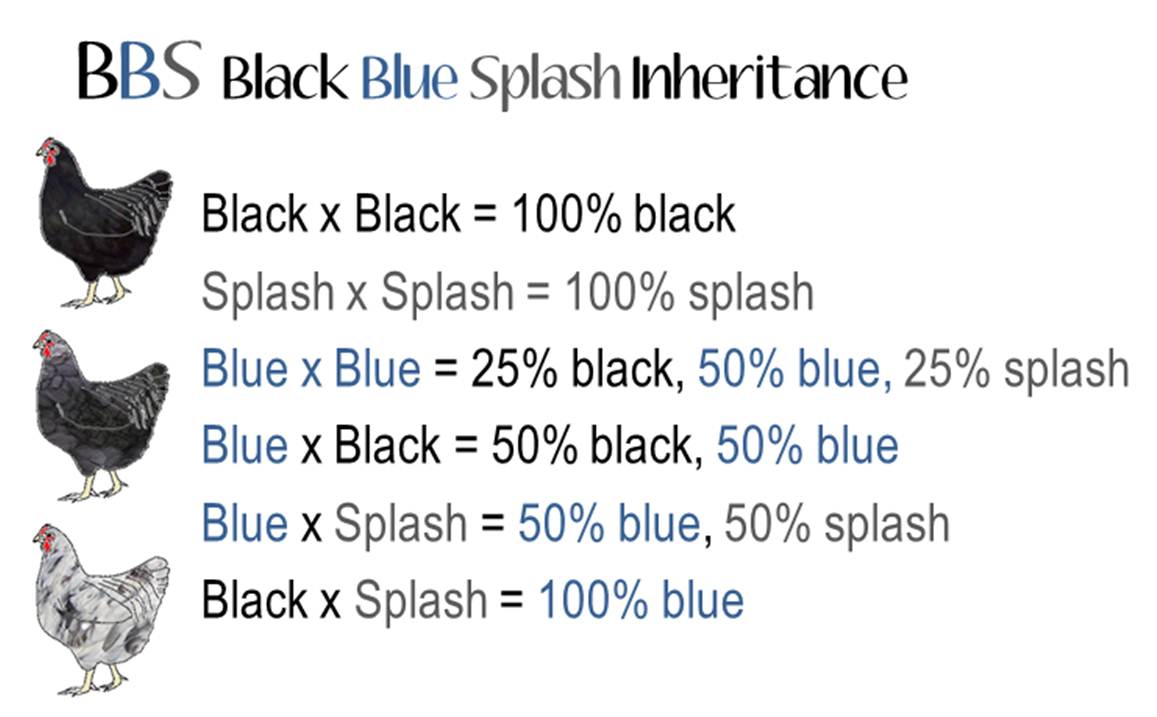
Blue/Black/Splash Genetics
The blue-black splash gene in chickens refers to a specific genetic trait that influences the color of a chicken's feathers.
Understanding this gene involves knowing how it interacts with other color genes in chickens.
-
When this gene is passed down it creates a specific coloration in the offspring, which is high predictable. Expression of the blue-black-splash gene variants results in a chicken with a distinctive appearance.
The blue gene dilutes the black pigment, giving the feathers a grey-blue coloration. If there are two Blue genes present, the black is diluted even further resulting in a bird that is mostly white with grey-blue spots, creating a visually striking and unique appearance.
-
Learn more about BBS Genetics here
It's important to note that understanding chicken feather color genetics involves considering multiple genes and their interactions. Different combinations of genes can result in a wide variety of plumage colors and patterns in chickens. Blue-black-splash genetic inheritance is just one example of how genetic factors contribute to the diversity of chicken colors observed in various breeds.

Ermine Ameraucana
Our Ermine Ameraucana coop is a work in progress. We anticipate our hatching eggs to become available around Spring 2026. Follow along with our progress @AkersFamilyFarm on FB.
The Ermine Ameraucana is a variety of the Ameraucana breed, known for its distinctive beard, muff, and pea comb, as well as its ability to lay blue eggs. The “ermine” color pattern refers to white and black distinct plumage throughout the entire body of the chicken. This gives the birds a striking appearance. Ermine Ameraucanas are medium-sized, have a friendly and calm demeanor, and are popular for backyard flocks due to their unique egg color and attractive look. Like other Ameraucanas, they are hardy and adapt well to various climates.

